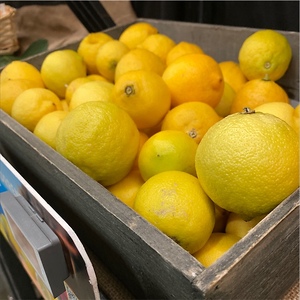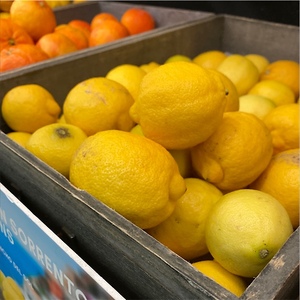


Italian Sorrento Lemons
Estimated Inventory, 25 lbs : 4.14
This item was last sold on : 06/30/25
Description/Taste
Sorrento lemons are a medium to large varietal with a somewhat bulbous, oval shape, tapering slightly at each end. The stem end typically displays a flatter edge, while the opposite end showcases a distinct, protruding point known as a mammilla. The lemon’s peel is semi-thick and glossy, covered in prominent oil glands giving the surface a textured, bumpy feel. The peel also ranges in color from yellow with faint green patches to bright golden yellow depending on maturity. Underneath the surface, there is a thick, white, and spongy pith tightly clinging to tender, aqueous, and translucent-yellow flesh. The flesh is divided into 10 to 12 segments by thin white membranes and is found seedless or containing a few cream-colored to ivory seeds. Sorrento lemons release highly fragrant essential oils from their peel, creating a refreshing, sweet, and bright aroma. The flesh is acidic and subtly sweet with a zesty, tart, and tangy flavor.
Seasons/Availability
Sorrento lemons are available year-round, with a peak season in the spring through fall.
Current Facts
Sorrento lemons, botanically classified as Citrus limon, are an Italian variety belonging to the Rutaceae family. The fragrant lemons are native to the Sorrento Peninsula and are one of the most famous types of lemons cultivated in Southern Italy. Sorrento lemon trees fruit up to four times a year, providing year-round production, and are grown in protected terraces along coastal mountainsides. There are many different names for Sorrento lemons, depending on the region in which they are grown, but true Sorrento lemons are cultivated in a protected region on the island of Capri and the Sorrento Peninsula. Lemons produced in this small region are given an Indication of Geographic Protection, or IGP, which acknowledges that the lemons grown in this region have a distinct flavor, peel thickness, and aroma that cannot be fully replicated outside of the area. Within the Sorrento Peninsula, Sorrento lemons are also known as Ovale di Sorrento, Limone di Sorrento, Massese lemons, Massa Lubrense lemons, Limone di Massa Lubrense, and Massa lemons. Outside of the peninsula, Sorrento lemons are sometimes labeled as Femminello Ovale or Femminello Santa Teresa. In Italy, approximately 40% of the Sorrento lemons are cultivated for domestic and international fresh markets, while 60% are utilized for processed products.
Nutritional Value
Sorrento lemons are an excellent source of vitamin C to strengthen the immune system while reducing inflammation, fiber to regulate the digestive tract, and folate to develop healthy red blood cells. The lemons also provide potassium to balance fluid levels within the body, magnesium to maintain optimum nerve functioning, phosphorus and calcium to build strong bones and teeth, and other nutrients such as B vitamins, zinc, copper, and iron. In addition to vitamins and minerals, Sorrento lemons contain limonene. This natural compound provides anti-inflammatory and antioxidant properties to protect the cells from the damage caused by free radicals.
Applications
Sorrento lemons are highly acidic, providing a bright flavoring for raw and cooked preparations. The lemon’s zest, rind, and juice can be incorporated into oils, vinegar, dressings, sauces, and marinades, or halves of the fruit can be squeezed directly over grain bowls, seafood, soups, curries, and stews for a pop of acidity. Sorrento lemons can also be roasted alongside meats and vegetables, sliced thinly and sprinkled with salt or sugar as a snack, layered and stuffed into poultry, or zested over pasta. It is important to note that Sorrento lemons can be used interchangeably in recipes calling for common lemons. The citrus provides a tangy, acidic taste to anything it is squeezed over, creating aromatic depth and complexity. In addition to savory preparations, Sorrento lemons can be used to flavor cakes, pies, tarts, scones, muffins, and cookies, or they can be zested over parfaits, ice cream, or sorbet. The lemons can also be simmered into preserves or custards, boiled into sugar to create a candied lemon peel, or salted and cured for extended use. Beyond culinary preparations, Sorrento lemons can be juiced and stirred into cocktails, lemonade, tea, and other sparkling beverages. Italian Sorrento Lemons pair well with other fruits such as guavas, mangoes, passion fruits, coconut, blueberries, and apples, herbs including mint, sage, oregano, rosemary, and basil, and seafood such as octopus, shrimp, and fish. Whole, unwashed Sorrento lemons will keep 7 to 10 days at room temperature or 3 to 4 weeks when stored in the refrigerator.
Ethnic/Cultural Info
Sorrento lemons are most popularly used in the production of limoncello. The exact history of limoncello is unknown, as several different legends are being touted as the true history throughout the various production regions of Sorrento, Capri, and Amalfi. The refreshing beverage has been made in Italy for at least 100 years and is a customary drink to serve to house guests. Around 60% of all cultivated Sorrento lemons in Italy are reserved for making the sweet Italian liqueur. Authentic limoncello is produced from the peel of Sorrento lemons grown on farms on the island of Capri and in a region between Massa Lubrense and Vico Equense, two Italian coastal towns approximately 25 minutes apart on the Sorrento Peninsula. The lemons are traditionally hand-harvested to prevent the fruits from touching the ground, and the most aromatic lemons are selected for the beverage creation. Limoncello is made from lemon zest or pieces of the thick rind combined with sugar, alcohol, and water. It takes approximately 80 days for the drink to be ready for consumption, and in Italy, limoncello is served cold as an after-dinner digestif or between-course aperitif. In Sorrento, Limoncello is crafted by local artisans and is also made in home kitchens from home-grown lemons. Limoncello is customarily a small-batch creation, and the drink will vary in flavor, color, and aroma depending on the region and lemons used.
Geography/History
Sorrento lemons are native to the Sorrento Peninsula, a region in Southern Italy situated between the Gulf of Salerno and the Gulf of Naples and the nearby island of Capri, located south of Naples in the western part of Campania. The variety was believed to have been a spontaneous mutation found on a femminello lemon tree near Sorrento sometime during the 16th century. Experts note that lemons came to Italy via travelers along the Silk Road, though some believe Jewish immigrants first brought them to the area in the 1st century CE. Roman settlers also arrived in the area and began cultivating the lemons, documenting the citrus in paintings and mosaics in Pompeii and Herculaneum. These lemon varieties were thought to have been the early ancestors of Sorrento lemons. Later in the 17th century, Jesuit Fathers began cultivating lemons in the Sorrento area and created some of the first commercial groves. The Sorrento Peninsula is comprised of rocky coastline and mountainous regions that receive ample amounts of sunshine, developing a unique microclimate suitable for citrus cultivation. There is also a lack of available land for citrus production, leading many farms to use the natural contours of the mountains to build terraces suitable for small agricultural plots. These terraces often include walled plots and updated pagliarelles, a structural system once made from chestnut wood that provides controlled temperature, shade, and protection from harmful elements and pests. In the early 2000s, Sorrento lemons earned their own Indication of Geographic Protection or IGP, and, through a dedicated consortium, are protected and marketed. Today Sorrento lemons are almost exclusively grown by small family farms in Capri and the Sorrento Peninsula, especially in Massa Lubrense, Vico Equense, Meta, Sant’Agnello, and Piano di Sorrento, and sold through local markets and a few select distributors. The lemons are also exported to England, Germany, and other European markets. Outside of Italy, Sorrento lemons are grown in limited quantities in California.
Featured Restaurants
Restaurants currently purchasing this product as an ingredient for their menu.
| Oliver & Rose | San Diego CA | 619-300-3395 |
| Andrew Spurgin | San Diego CA | 619-277-6020 |
| Sago | Encinitas CA | 858-382-4047 |
| Marisi La Jolla | La Jolla CA | 951-852-6730 |
| InterContinental Vistal Kitchen | San Diego CA | 619-501-9400 |
Recipe Ideas
Recipes that include Italian Sorrento Lemons. One
| I Am A Food Blog |
|
Shrimp and Spring Vegetable Cauliflower Rice Paella |

















